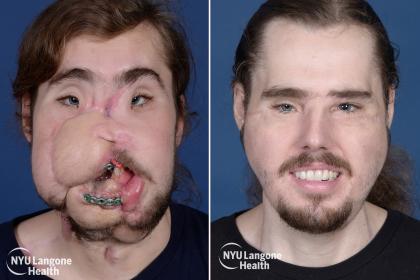- Home
- Editorial
- News
- Practice Guidelines
- Anesthesiology Guidelines
- Cancer Guidelines
- Cardiac Sciences Guidelines
- Critical Care Guidelines
- Dentistry Guidelines
- Dermatology Guidelines
- Diabetes and Endo Guidelines
- Diagnostics Guidelines
- ENT Guidelines
- Featured Practice Guidelines
- Gastroenterology Guidelines
- Geriatrics Guidelines
- Medicine Guidelines
- Nephrology Guidelines
- Neurosciences Guidelines
- Obs and Gynae Guidelines
- Ophthalmology Guidelines
- Orthopaedics Guidelines
- Paediatrics Guidelines
- Psychiatry Guidelines
- Pulmonology Guidelines
- Radiology Guidelines
- Surgery Guidelines
- Urology Guidelines
Successful full face transplant gives new lease of life to suicide survivor

New York: A 26-year-old man got a new lease of life when a team of surgeons successfully performed a face transplant that cost $1.5 million. The man, Cameron Underwood, in a suicide bid had caused an injury to his face with a gunshot after hours of drinking at home on June 2016. As a result of which, he lost most of his teeth, nose and lower jaw and also damaged his maxillary and palate.
The team used facial skin from New York-based Will Fisher, a 23-year-old writer, and filmmaker, to replace much of the man's face, as well as partial replacement of his bone structure.
The procedure was performed by a face transplant team consisting of over 100 medical professionals at New York University Langone Medical Center.

Credits: NYU Langone Medical Center
The surgical team, led by Dr. Eduardo D. Rodriguez — the Helen L. Kimmel professor of reconstructive plastic surgery and chair of the Hansjörg Wyss Department of Plastic Surgery at NYU Langone, performed the transplant surgery on January 5, 2018. The procedure lasted 25 hours and ended the following morning. After the transplant, when Underwood's face had healed and the inflammation had subsided, the specialists performed several minor follow-up surgeries to achieve the best aesthetic results.
Also Read: 50-hour face transplant gives a new face to a wounded man
The surgeons used the following techniques to place the grafted face with a high level of precision:
- intraoperative CAT scan
- 3-D computer surgical planning
- intraoperative navigation
- 3-D-printed cutting guides tailored to the patient
The surgery resulted in replacement and reconstruction of the patient's lower and upper jaws, the roof and floor of the mouth, 32 teeth and gums, the nose and part of the nasal passage and the lower eyelids and cheeks. For this, the team used the entire middle and lowe
The surgeons used the entire middle and lower parts of the donor's face and skull to complete the transplant. In all, they replaced and reconstructed the patient's upper and lower jaws, 32 teeth and gums, the roof and floor of the mouth, the lower eyelids and cheeks, and the nose and part of the nasal passage.
They used an innovative approach for preserving the identity of the donated face: a 3-D-printed mask of the donor's features.
"Technical advances have increased our ability to tackle the most complex cases more precisely with maximal aesthetic and functional results," says Dr. Rodriguez.
"Advances in medical technology allow us to more rapidly evaluate donors and recipients for [a] face transplant, and to perform surgery more safely and efficiently," he adds.
The doctors also note that the first similar transplant they conducted lasted over 36 hours, so the fact that they managed to reduce surgery time by 11 hours is a highly significant achievement.
The first similar procedure lasted for over 36 hours, so reducing the surgery time by 11 hours is a highly significant achievement, noted the doctors. "Having already done two face transplants, we identified even before we entered the [operating room] where we could reduce surgical time," Dr. Rodriguez says.
"This is critically important," he adds, "not only from a fatigue factor for the surgical team but also for Cameron's recovery. A shorter surgery often translates into less risk of complications."
Also Read: Should we keep doing face transplants?
Significant achievements of the surgical team in comparison to the first transplant performed:
- The number of days spent in ICU forUnderwood was 23, compared with 62 days for the patients who underwent the first transplant.
- The total length of stay in the hospital was 37 days, compared with 62 days for the first patient.
- The number of days spent in rehabilitation reduced to almost halve, from 13 to 7.
Dr. Bruce E. Gelb, a transplant surgeon at NYU Langone who also participated in Underwood's transplant, comments, "We are thrilled that Cameron is responding so well to the transplant."
"Our team has established a successful, novel, patient-donor matching protocol and immune suppression regimen that we believe provides the best outcomes for our patients because the risk of rejection and toxicity is greatly minimized.
Click on the link to watch the surgical procedure of the transplant: https://youtu.be/cKnw7HWzbGU

Disclaimer: This site is primarily intended for healthcare professionals. Any content/information on this website does not replace the advice of medical and/or health professionals and should not be construed as medical/diagnostic advice/endorsement or prescription. Use of this site is subject to our terms of use, privacy policy, advertisement policy. © 2020 Minerva Medical Treatment Pvt Ltd